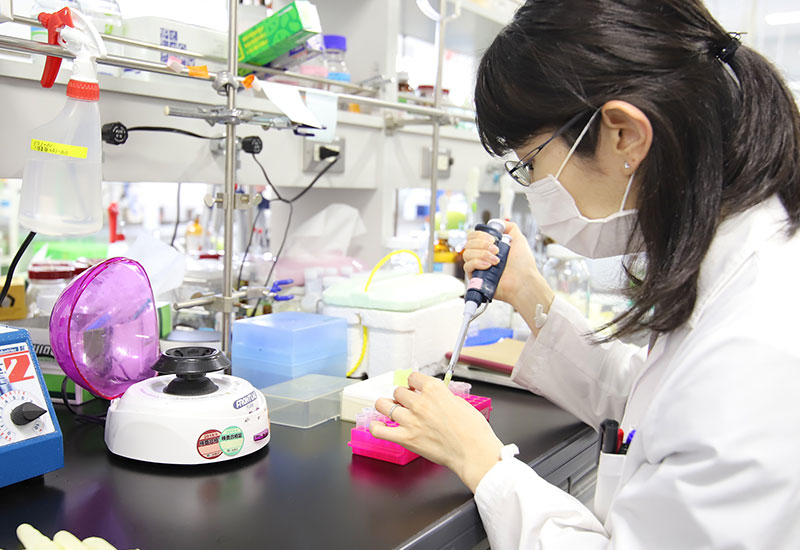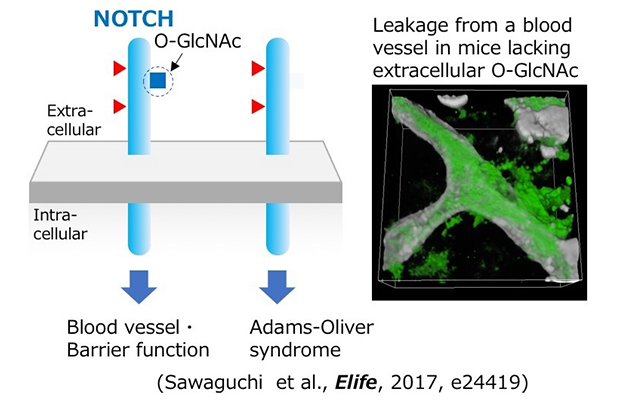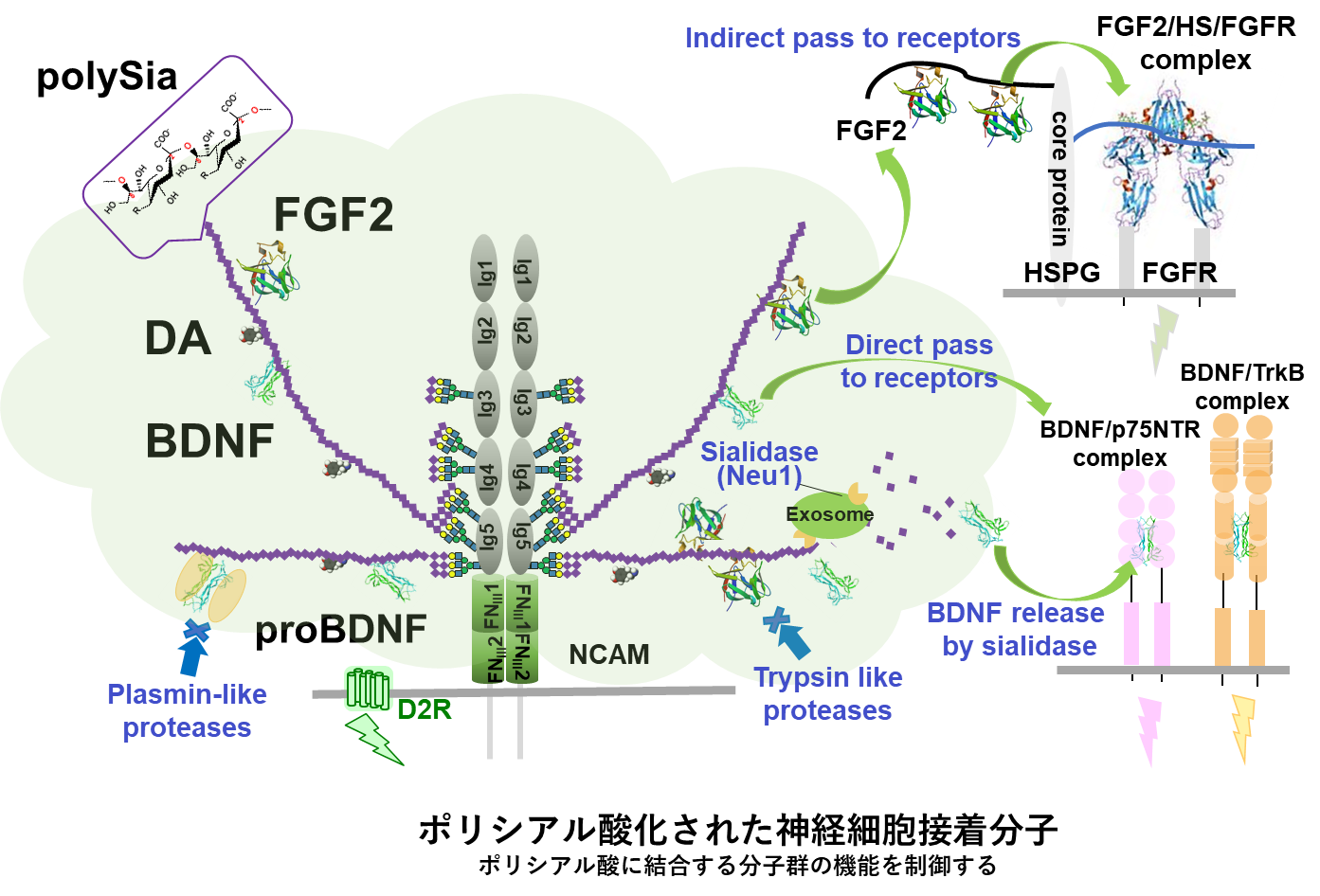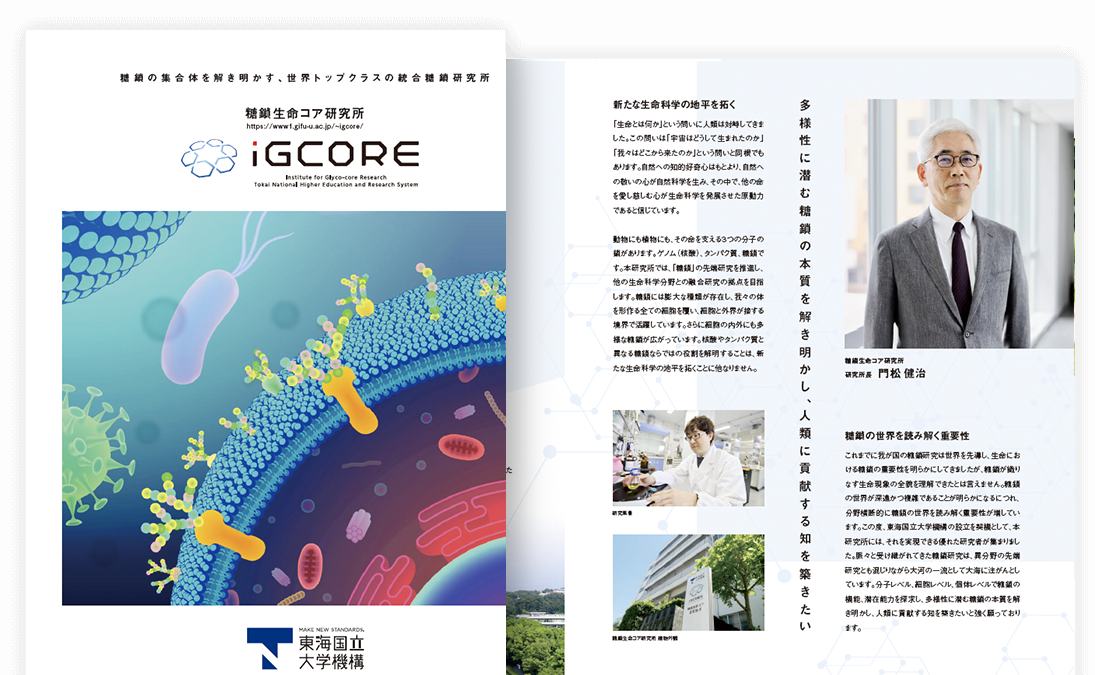RESEARCH
Molecular Physiology and Dynamics Division
Purpose / Contents

Understanding the functions and dynamics of glycans at cellular and molecular levels
The Molecular Physiology Division in the Integrated Glyco-BioMedical Research Center (iGMED) focuses on how glycans are assembled and localized in cells to explain the mechanisms underlying these phenomena. Studies in this area also aim to reveal the principles of how glycans are colocalized and interact with other molecules. In addition, this division will develop chemical compounds and methods to regulate these processes.
This division’s goal is to elucidate the biosynthesis, localization, and interaction of glycans with other molecules by employing biochemical, genetic, and structural biology approaches. Through this research, we aim to gain a better understanding of how glycan assemblies are biosynthesized in cells. Additionally, we aim to synthesize assembled glycans by utilizing supramolecular chemistry and develop novel methods to regulate Glycan domains using chemical biology and artificial gene products.
Examples

Loss of O-GlcNAc causes vascular defects
We found that a unique glycan called extracellular O-GlcNAc controls the functions of NOTCH protein, an important factor for tissue development and morphogenesis, and that loss of extracellular O-GlcNAc causes defects in vascular functions
(Sawaguchi et al., eLife, 2017, e24419).

Structure and function of disease-related glycan, Polysialic acid
Structure and function of disease-related glycan, Polysialic acid, an acidic polysaccharide highly expressed in the brain, comprises 8-400 sialic acid residues and is involved in neurogenesis, memory formation, and behavior. By investigating the structures and functions of this glycan, we have revealed its association with mental disorders such as schizophrenia, as well as cancer malignancy.
(Sato et al. Mol Aspects Med. 2021 79, ).
Members List
Chihiro Sato
Vice-DirectorChairMolecular Physiology Division
- Research interests
- PolySia, Sialic acid, molecular interaction, acidic polysaccharide, disease, mental disease, cancer
- Research subject
- Glycans cover cell surface in all organisms and maintain cellular homeostasis by mediating cell-cell and cell-extracellular communication. Abnormal glycan structures cause various dysfunctions and diseases (mental disease, cancer, etc). We conduct interdisciplinary research covering medical, pharmaceutical and agricultural sciences, aiming at contributing to better health, environment and food, by understanding and regulating glycan functions at molecular, cellular, tissue, and individual levels. In particular, we conduct basic research on the structures and functions of PolySia as well as applied science such as development of probes. We try to conduct research from wide viewpoints, covering from evolution to disease.
Tetsuya Okajima
Division headMolecular Physiology Division
- Research interests
- O-GlcNAc, mass spectrometry, disease
- Research subject
- We have so far identified novel glycans and revealed their functions, by focusing on Notch receptor which is involved in tumors and neurodegenerative diseases. We try to further understand glycan functions and develop novel therapeutic strategies targeting glycans. In addition, by using advanced recent techniques for analyzing glycopeptide with mass spectrometry, we will conduct medical and drug discovery studies.
Hiroshi Abe
Molecular Physiology Division
- Research interests
- medicinal chemistry, nucleic acid chemistry, mRNA, DNA, biotechnology
- Research subject
- We focus on drug discovery and biotechnology technologies based on nucleic acid chemistry. To date, we have achieved the world's first complete chemical synthesis of mRNA. Using this technology, highly active mRNA vaccines are developed. We also develop tissue-specific delivery technology by using sugar functions, genome-sized DNA synthesis technology, and synthetic biology of useful microorganisms leading to material production.
Takayuki Uchihashi
Molecular Physiology Division
- Research interests
- High-speed atomic force microscope (AFM), single molecule measurement, dynamics, protein
- Research subject
- By using HS-AFM, we develop methods for analyzing single molecule dynamics. Using single molecule imaging, we aim to elucidate the mechanisms of how proteins exert their functions.
Atsunori Oshima
Molecular Physiology Division
- Research interests
- Structural biology, membrane protein, cryo-EM, cell-cell communication, membrane lipid
- Research subject
- To understand signal transduction via plasma membrane, we mainly analyze membrane proteins. In detail, we try to reveal open-close mechanisms of channels, recognition mechanisms of ligands or compounds by pumps and GPCRs. We also try to develop and optimize techniques of sample preparation for high-resolution structural analysis using cryo-EM. We use methods for reconstitution of membrane proteins into lipid nanodiscs for structural analysis.
Tomoo Ogi
Molecular Physiology Division
- Research interests
- Genome analysis in disease, genome instability
- Research subject
- We use cutting-edge techniques, such as next-generation genome analysis and next-generation transcriptomics. We aim to identify novel gene variants responsible for diseases and to reveal molecular functions of gene variants. We also try to elucidate pathology using disease model mice.
Takahiro Shibata
Molecular Physiology Division
- Research interests
- Oxidative stress, posttranslational modification, food component, extracellular vesicle, bioactive lipid
- Research subject
- We analyze the mechanisms of activity of food components for preventing lifestyle-related diseases. In addition, we search for disease markers focusing on oxidative stress-induced posttranslational modifications and extracellular vesicles.
Midori Shimada
Molecular Physiology Division
- Research subject
- Our laboratory conducts integrated research to elucidate the regulatory mechanisms of gene expression and protein degradation, which are fundamental to biological phenomena, and to identify therapeutic targets and develop strategies for cancer treatment based on information from life science databases.
Yoshikatsu Matsubayashi
Molecular Physiology Division
- Research interests
- Arapidopsis thaliana, O-linked glycan, arabinose, arabinogalactan protein
- Research subject
- Two types of protein glycosylation are known, N-linked and O-linked glycans. The basic biosynthetic mechanisms of the N-glycans are similar between plants and animals. On the other hand, non-reducing end sugars and amino acids to which O-glycans are attached differ greatly between plants and animals, and it is known that arabinose and galactose are added to hydroxyproline (Hyp) in plants. We discovered the glycosyltransferases involved in Hyp O-arabinosylation and galactosylation and investigate various physiological functions of O-glycans in plants by phenotypic analysis of the strains deficient in these enzymes.
HIroaki Wake
Molecular Physiology Division
- Research interests
- in vivo two photon holographic microscope, glia, multi-cellular dynamics
- Research subject
- Higher brain functions such as learning, memory, and emotion are efficiently expressed by individual neuronal activity in multiple brain regions performing spatiotemporally organized activities and creating descriptive neuronal population activities (= neural circuit activities). We are using in vivo imaging to visualize the structure and function of neurons and glial cells required for higher brain functions and to elucidate the changes in these physiological functions and pathological conditions.
Akinori Nakamura
Molecular Physiology Division
Yu Nakagawa
Molecular Physiology Division
- Research interests
- Natural compound, carbohydrate recognition, antibiotics, molecular design, analysis of molecular interaction
- Research subject
- We focus on natural small compounds that bind to biologically or pathologically important glycans, and we analyze the molecular mechanisms for the binding. Based on this knowledge, we develop molecular tools for glycoscience and drug leads targeting glycans by chemical modification of the natural products.
Kwok Kei MAK
Molecular Physiology Division
- Research interests
- Psychiatric epidemiology, meta-analysis, machine learning
- Research subject
- Genome-wide association studies (GWAS) of N-glycome profile changes in brain disorders and diabetes
Nao Yamakawa
Molecular Physiology Division
- Research interests
- Glycoconjugate structural analysis, Glycan Modification, Sialic Acid, Glycan diversity studies
- Research subject
- My research centers on developing and applying advanced analytical techniques—integrating mass spectrometry, chromatography, and analytical chemistry—to elucidate the structures of complex glycans and glycoconjugates. I am dedicated to uncovering novel and elusive glycan architectures and advancing our understanding of their diverse biological functions.
Yuji Kondo
Molecular Physiology Division
- Research interests
- Tissue expression profiling of glycosyltransferases, Reverse genetics, Click-chemistry, single cell RNA analysis, super resolution microscope
- Research subject
- By using advanced technologies, I try to establish a system that allows us to analyze endogenous glycan structures and functions on particular proteins at single cell level.
Yuko Tashima
Molecular Physiology Division
- Research interests
- O-glycan, Proteostasis, NOTCH
- Research subject
- We aim to elucidate the mechanism of O-glycan-mediated proteostasis (maintaining proper protein expression). We focus on NOTCH receptor, which is heavily O-glycosylated and plays key roles in the NOTCH signaling pathway essential for cell differentiation and homeostasis.
Masaya Hane
Molecular Physiology Division
- Research interests
- PolySia, sialic acid, molecular interaction, anti-glycan antibody
- Research subject
- Aiming at research from a broad perspective ranging from evolution to disease, we conduct basic research on the structures and functions of polysialic acid (Polysia), their relationship to disease, and applied research such as development of probes.
Research Division
Contact us by phone

052-789-5365
( +81-52-789-5365 )
Weekday, 9:00-17:00
Contact us




